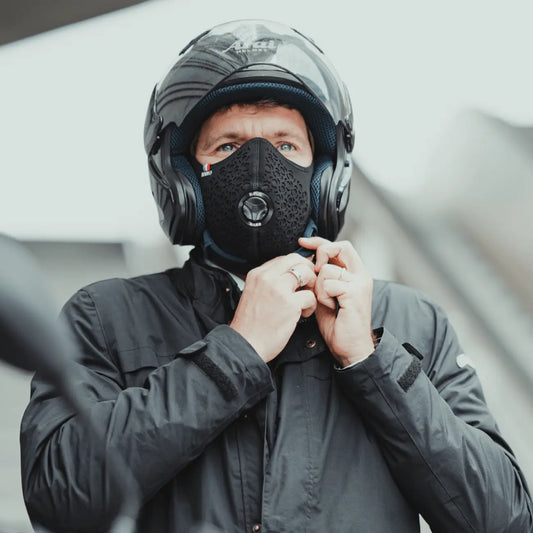
In large cities, the air pollution represents a real public health issue. Faced with this growing problem, many people are turning to solutions such as anti-pollution mask to preserve their respiratory capacity . But is it really effective? Dive into the heart of a subject that concerns each of us.
Why does urban pollution affect our breathing?
Modern metropolises are often shrouded in a haze of fine particles. These pollutants, mainly from road traffic and industrial, penetrate deep into our lungs, causing various health problems. These nuisances include throat irritation , decreased breathing capacity, and even more serious chronic diseases.
In addition to particulate matter, chemicals in polluted air, such as sulfur dioxide and ozone, further exacerbate breathing difficulties. Living or working in such an environment day after day can seriously impact quality of life.
Increase in cases of respiratory diseases
Over the years, there has been a notable increase in cases of asthma, chronic bronchitis, and other respiratory diseases in urban areas. Researchers largely attribute this trend to continued exposure to high levels of pollution in cities.
Furthermore, some studies show that children living in highly polluted areas also suffer more frequently from respiratory problems , which underlines the urgency of action to find viable solutions to reduce the impact of pollution on human health.
The role of anti-pollution masks: a viable solution?
THE anti-pollution masks come in different forms, each with its own specific characteristics of particle filtration . The question many seek answers to is: can they really help us breathe more easily in a polluted environment?
These masks work primarily by filtering fine particles, preventing them from entering the respiratory tract. Some models, such as the FFP2 masks And FFP3 respirators offer a higher level of protection thanks to their advanced filtration systems. But how effective are they in the field?
Mask effectiveness depending on conditions of use
The effectiveness of the anti-pollution mask The effectiveness of the mask depends greatly on the conditions of use. It is crucial to ensure that it fits properly to the face to guarantee optimal protection. An unsuitable mask allows pollutants to pass through, drastically reducing its effectiveness.
Masks equipped with breathing valves They facilitate airflow, making breathing easier, especially during moderate physical activity. That said, the choice between different types of masks should reflect individual needs and the level of pollution one faces.
Surgical masks versus high-filtering masks
Although widely used during the pandemic, surgical masks are not designed to provide protection against air pollution. Their filtration capacity is limited compared to masks specially designed for this purpose.
In contrast, FFP2 and FFP3 masks demonstrated significantly higher efficiency in capturing fine particles . If you live in a city with high pollution levels, opting for these models could be wise to reduce respiratory discomfort.
How to choose the right anti-pollution mask?
Selecting an effective mask relies on several essential criteria. In addition to the filtration level, comfort of use should be considered, especially if the mask is expected to be worn for long periods each day.
It is also advisable to check if there are any specific recommendations or certifications guaranteeing the quality of the product. Ultimately, choosing the right mask comes down to wisely evaluating between protection , comfort and cost.
Essential criteria when purchasing
- Filtration level: Check that the mask provides adequate protection against fine particles, including PM2.5 and PM10.
- Fit and comfort: Make sure the mask fits well without leaving gaps where particles could enter.
- Sustainability : Some reusable masks can be cleaned, while others require frequent replacement.
- Presence of breathing valves: They facilitate ventilation, particularly useful during physical activities.
To make it easier to find the mask that suits you, it may be beneficial to test different models before deciding which one best meets your specific expectations.
Why do R-PUR masks stand out from the others?
Among the many options available on the market, R-PUR masks stand out thanks to their particularly advanced filtration technology, designed for cyclists, motorcyclists and, more broadly, health-conscious city dwellers.
Equipped with a filtration system superior to the FFP3 standard , these masks are capable of blocking not only fine particles PM2.5, PM10, but also nanoparticles and toxic gases. This efficiency makes them particularly suitable for densely polluted urban environments.
But performance isn't everything. Comfort is also a priority: the memory foam perfectly adapts to the contours of the face, ensuring long-term wear without irritation. The mask is 100% airtight thanks to a patented system, thus preventing any infiltration of polluted air. And unlike some rigid or restrictive models, the R-PUR are designed for smooth and natural breathing , even during physical exertion.
Whether you're riding a bike, a motorbike, or on foot, the R-PUR mask acts as a truly invisible barrier, combining technology, ergonomics, and design . It's no longer just about protecting yourself, but about breathing better... sustainably.
Additional precautions against pollution
Wearing a mask is a smart choice to combat the immediate effects of pollution, but it's only part of the solution. Adopting a healthy lifestyle and staying informed about the air quality remains essential to prevent health problems linked to pollution.
Many tools, such as mobile apps and municipal bulletins, now provide up-to-date information on air quality, encouraging people to take measures such as limiting outdoor activities during pollution peaks.
Incorporate healthy lifestyle habits
In addition to consistently wearing a mask, incorporating dietary and exercise tips can help strengthen the immune system. Consuming foods rich in antioxidants and engaging in regular physical exercise (ideally indoors when the air is saturated) helps maintain good physical fitness against external aggressions.
Getting closer to green spaces, away from the hustle and bustle of the city, also allows for a return to relatively better air quality, thus providing a beneficial rest for the lungs. Of course, all of these individual initiatives should ideally be accompanied by public policies committed to reducing urban pollution.



